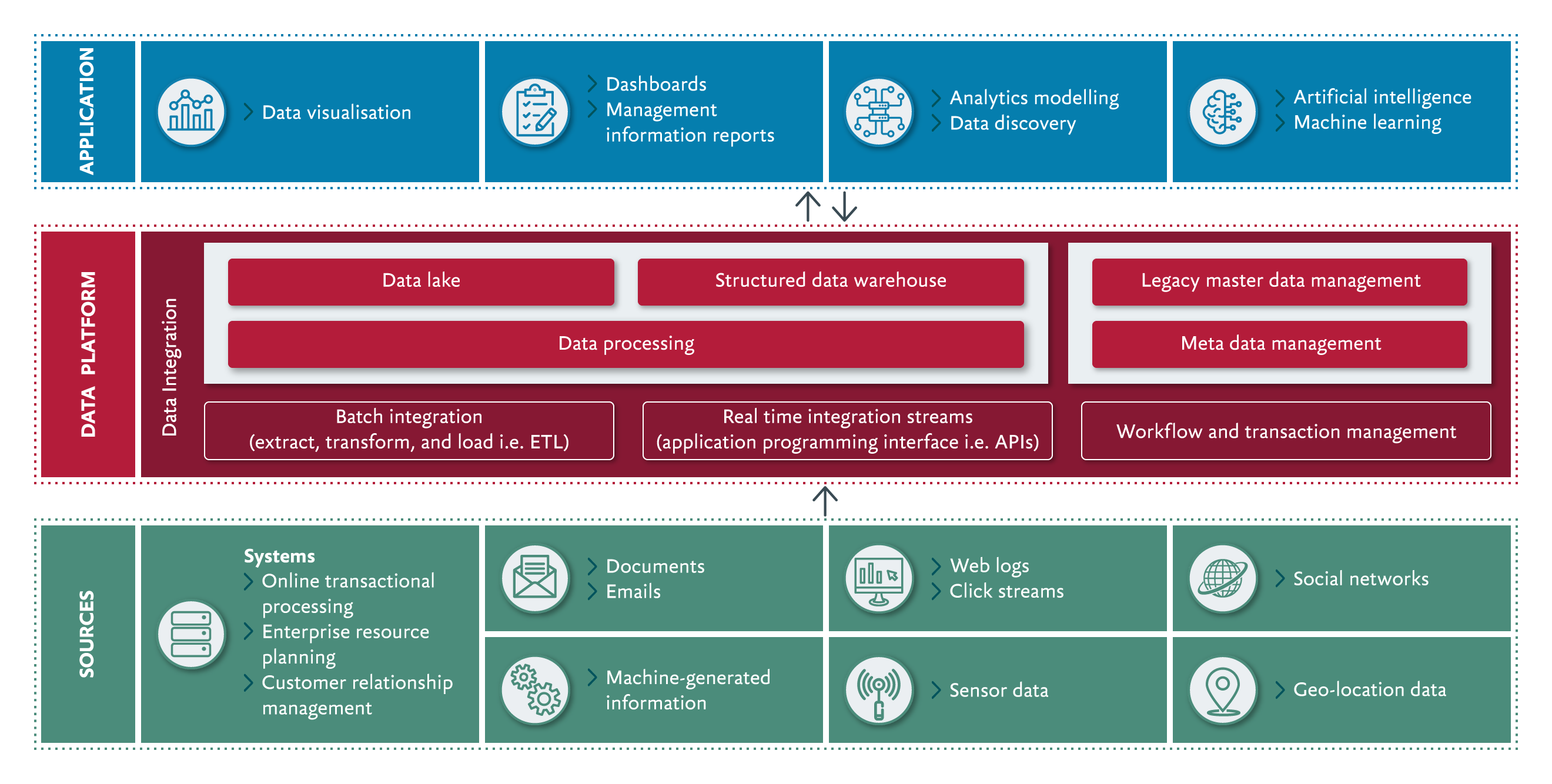Insight
The six components of a data strategy
Organisations have access to data like never before, and unlocking the value of that data is top of the agenda for many leaders. Often, they know they need to invest in better data and analytics capabilities but don’t always know how to take a strategic approach.
Our view is that to develop a successful data strategy, you need to consider six key components.

The vision, strategy and roadmap for data and analytics
Leaders need to start with aligning data and analytics capabilities to the organisation’s wider business strategy. By assessing overall business objectives, you can develop a corresponding overall vision for data and analytics, with a better understanding of the key areas where data will help you.
From there, you can then set specific objectives. This will usually involve balancing your focus between the ‘top line’, such as growth through product innovation or customer insight analytics, and the ‘bottom line’, such as efficiencies in current reporting and data management that reduce operational costs.
You need to ensure alignment among senior stakeholders too, gaining their initial buy-in and continued commitment. To turn data and analytics objectives into progress towards real outcomes, it’s essential to have clear executive sponsorship and leadership.
Then, you’ll need to build a realistic roadmap for realising your strategy, which will include assessing the level of investment required and the business case. Consider the sequence, timing and transition states for putting all the capabilities in place, as well as the mechanisms for leading and driving the implementation.
Governance over data and analytics
Robust data governance requires defining the organisational accountability for information. This involves defining the controls, decision-making processes and forums for data standards, data quality and data compliance.
Data governance needs to not only cover these bases but also integrate effectively with both IT governance and wider business governance.
Information operations
This component involves defining a ‘single source of truth’ for each key data set, and then documenting how and where data is created, maintained, updated, archived and deleted. Data must be trustworthy across the organisation. You need to consider data quality across all elements: completeness, consistency, accuracy, timeliness, availability, reliability and uniqueness. This component is also about defining the tooling, process and procedures that allow you to effectively manage all day-to-day data operations (e.g. to manage data quality), whether manual, automated or ad-hoc.
Structuring the organisation and roles to enable data and analytics
A good data strategy will take into account the organisation structure, roles and skills needed to enable the required data and analytics capabilities. Considerations include:
Do you want a centralised, federated or hybrid capability?
- A centralised capability for data and analytics would have a function to support all business functions.
- A federated structure would embed data and analytics capability within individual functions.
- A hybrid option would combine a centralised data and analytics centre of excellence with select embedded capabilities in individual business function. The specific distribution of roles and responsibilities would depend on the needs of the organisation.
Do you want to outsource or fulfil internally?
- Depending on the strength of internal capabilities, companies may want to consider outsourcing for specific specialist data roles or services.
- Companies should consider that these functions may become the ‘brain’ of the organisation, and so risks vesting key knowledge with people outside the organisation. This is especially the case for advanced analytics.
Where do you want to locate your data and analytics capabilities?
- Data and analytics capabilities are most effective when they are cross-functional and accessible from across the organisation.
- A centre of excellence may involve creating a ‘physical’ or ‘virtual’ team. The former would involve appointing new hires or moving existing people into a dedicated new team. The latter would see the creation of a network of people in different roles or functions, who also take up an additional data and analytics role or responsibility.
Bear in mind that leveraging data and analytics is also about creating a data-led organisational culture, not just the right organisation structure and roles. Leaders should consider how they can foster such a culture within the context of overall organisational effectiveness.
Metrics and insights on data strategy success
Getting this component right means first developing a prioritised set of use cases for data and analytics. Each use case should map to and address business key performance indicators (KPIs).
Then you need to understand the metrics that will define and measure the success of your overall data strategy. These metrics should help you answer questions such as:
- Are you successfully putting in place the data and analytics capabilities?
- Are your data and analytics capabilities running well presently and continually developing and maturing?
- Are the data and analytics capabilities driving the intended business value?
The right architecture for data and analytics
A strong data and analytics architecture will support the interdependencies between data sources, data platforms, and data applications. This should cover both the technology landscape for data and enterprise data architecture, describing and modelling a consistent, cross-functional view of data entities and how they relate to one another.
Data and analytics architecture examples

Business needs should drive your data and analytics technology
Developing a strong data strategy requires careful consideration of many factors. While making these considerations may feel complex, a successful approach will always keep this core principle in mind: your data strategy should be driven first and foremost by the needs of the business.
A good strategy should ultimately give clarity over what information and insights you need to drive your business, who needs it, and when and how it will be delivered. This will ensure that your technology investment and adoption are led by the business need rather than the other way around. With this approach, you will ensure your data and analytics capabilities are not an end in themselves but will enable you to reach the desired business outcomes.











